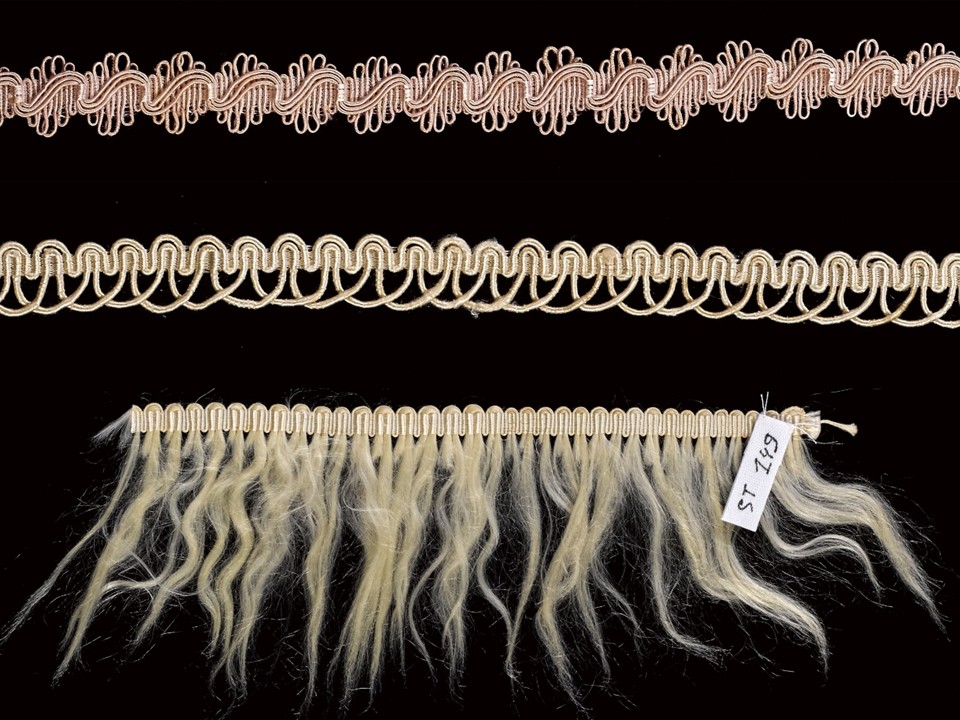
Published September 2025 as part of the proceedings of the first Alpaca conference on Algorithmic Patterns in the Creative Arts, according to the Creative Commons Attribution license. Copyright remains with the authors.
doi:10.5281/zenodo.17084418
Passementerie is a centuries-old craft defined by the Heritage Crafts Association (HCA) in the UK as ‘The making of elaborate trimmings such as tassels, braids, gold or silver cord, fringing or edgings for clothing or furnishings 1’. As may be obvious from its French name, it has strong historical connections with France, but has roots in many other countries as well. In the UK it is classified by the HCA as an endangered heritage craft, with only a handful of companies and individual craftspeople still active in the making of it.
Traditionally a luxury craft, using silk and gold threads, in the UK passementerie is still manufactured by companies such as Heritage Trimmings in Derby, in the East Midlands region which has a rich history of textile making. It is also handmade by passementerie artists including Elizabeth Ashdown, Jessica Light, and Anna Crutchley, who have modernised the craft by introducing different materials, and share their knowledge through workshops and books. 2 3 4. As passementerie can be made on an inexpensive frame loom, this knowledge-sharing could contribute to keeping the craft alive by building a community of hobbyist makers.
Examples of historical passementerie braids (and one fringe) can be seen in Figure 1. Their structure has a clear repeating pattern, or in other words, the weaving follows an algorithm. While passementerie is something of an umbrella term, covering fringes, tassels and other embellishments as well as woven structures, the focus of this work is just on woven passementerie because of this algorithmic aspect.

I learned about passementerie while researching metallic threads used in another heritage textile craft - goldwork embroidery - as both make use of gold threads and wires. As these materials are often conductive, this sparked my interest in combining passementerie with e-textiles, the intersection of electronics and textiles. And to explore mathematical patterns in the weaving structure. This essay describes some preliminary investigations, particularly on simulating the weaving of passementerie using p5.js, and making interactive e-textile demonstrators to represent binary numbers in passementerie weavings.
This builds on existing work on the intersection of modern technology and historical textile crafts. Within the e-textiles field, this includes Jones and Nabil’s in-depth work on goldwork embroidery 5, and bobbin lace making 6. Posch and Kurbak’s Embroidered Computer and larger Stitching Worlds project 7 also used goldwork embroidery techniques, crochet, and metallic threads, to create intricate and beautiful e-textile objects. And Townsend et al created an e-textile corset inspired by a lace archive in Nottingham, a city with strong ties to both machine-made and handmade lace 8.
There is also a lot of interesting work on algorithmic patterns in weaving and embroidery, such as Devendorf et al’s AdaCad software which harnesses parametric design 9, McLean’s Algorithmic Pattern project 10 and Cotterill and Buckby’s work on live coding and blackwork embroidery 11. These are just a few examples, but to date, it doesn’t seem like passementerie has formed part of these explorations. A passementerie braid features in Stitching Worlds book, but only as an example of a conductive material found at a flea market in Paris. All the more reason, therefore, to look into it.
Briefly, passementerie weaving consists of warp yarns, which are stretched taut and fixed to the loom from end to end, parallel to each other. And weft yarns, which are woven from side to side, over and under the warp yarns. This is standard weaving procedure, but what is different in passementerie is that there is a ‘main body weft’, which is woven normally, and a ‘decorative weft’, which is typically much thicker. The decorative weft isn’t pulled flush against the warp, but instead left loose to create passementerie’s characteristic loop designs. It is often made from stiff cord or textile-covered wire so that it holds its shape. A single passementerie weaving may contain multiple decorative wefts to create complex shapes.
The p5.js sketch in Figure 2 illustrates how a very simple passementerie weaving is made, illustrating just the weft yarns. Several rows of main body weft are woven, then the decorative weft is inserted. Another set of rows of main body weft are woven, and then the decorative weft is woven in again, creating the characteristic looping structure.
Figure 2. Passementerie Simulator: a simple animation of passementerie
Figure 3 depicts two more examples. These were woven in a passementerie masterclass by Elizabeth Ashdown, which I was able to participate in to get hands-on experience with the craft. I am using terminology from her book (cited above), which can be referred to for more information. In the left-hand sample, the number of main body weft rows alternates between 5 and 10. This creates wider loops (“scallops”) on the left hand side, and narrower loops (“picots”) on the right hand side. The ribbon used to create the decorative weft is flipped to create a colour change every 3rd decorative weft row (with one exception caused by the accidental weaving of an additional row, highlighted in the figure). This is a simple, repeating, (scallop)-(picot)-(colour change) pattern. The ‘crete’ pattern on the right hand side of the figure features two decorative wefts, woven in a symmetric 1-2-2-1 pattern that repeats. There are many permutations that can be made to these two basic patterns, e.g. varying the number of main body weft rows between decorative wefts, or changing the sequence that multiple decorative wefts are woven in, resulting in many possible patterns.
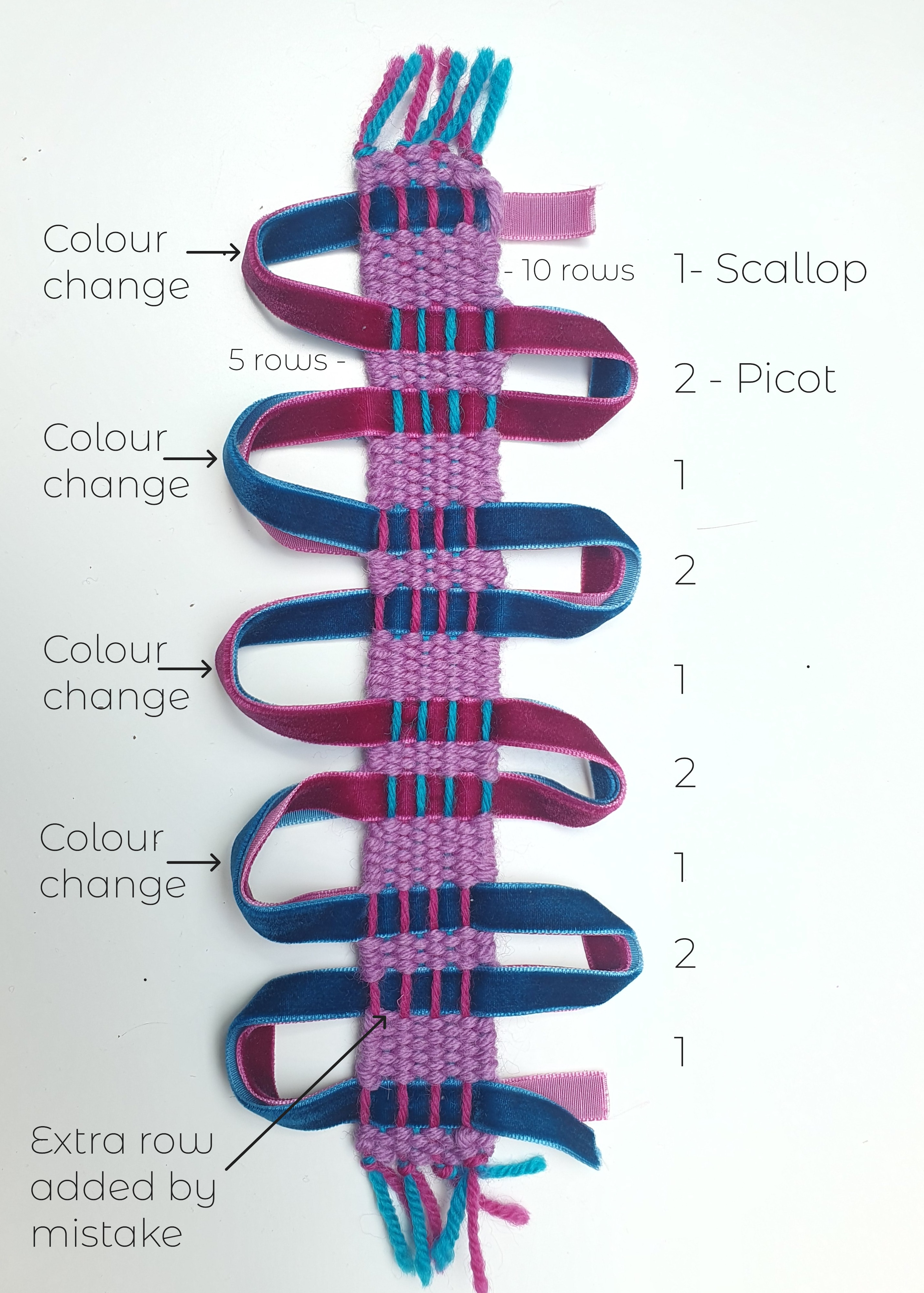
Figure 3: Patterns in two passementerie weavings: picot-scallop pattern (left) and crete (right)
The passementerie samples above all have regular, repeating patterns. But if we drop this requirement, passementerie can be used to represent binary numbers, i.e. to encode information. If we weave a decorative weft every nth row, each of these rows can represent a digit in a binary number (we can call these ‘digit rows’). Taking a second decorative weft, weaving it through a digit row represents a 1, and skipping that row represents a zero. For readers who aren’t familiar with binary, the concept is explained here and a simple explanation on conversion between decimal and binary here.
The concept is visualised using p5.js in Figure 4, as a rough simulation. The placement of the warp and weft isn’t completely accurate, and binary numbers are conventionally written left to right, not right to left, but this simulation still visualises the basic concept. The bit length (number of digits in the binary number) and number can be varied to see how different numbers look in passementerie binary form. Technically there isn’t a need for a ‘zero’ row, but this was included for the purpose of making an interactive demonstrator, which is covered in the next section.
Figure 4: p5.js visualisation of ‘passementerie bits’
To demonstrate the concept in physical form, it would be possible just to weave samples representing different numbers, where the value of the number can be interpreted by looking at the pattern. But it is more interesting and meaningful if these can be interactive, which can be achieved with e-textiles. Several prototypes were woven on a frame loom, using double knit wool yarn as the warp and main body weft, and a supplementary warp of silver conductive thread. Several different metallic threads for goldwork embroidery (bought from Golden Hinde Goldwork Supplies in Warrington, England), and velvet ribbon, were used as decorative warp.
As illustrated in Figure 5, each conductive warp thread represents a digit of a 5 bit binary number, and connects to an analog pin on an Arduino Uno. The conductive decorative weft connects to a ground pin on the Arduino. The conductive warp is selectively picked up so that each conductive warp thread can only connect to the conductive weft in the correct row. The ribbon helps insulate the other conductive warp yarns from the weft yarn. If the conductive weft is woven into the row that corresponds to a particular digit, it comes into contact with the warp yarn representing that digit, and the Arduino detects a closed circuit. If the conductive weft is not woven into that row, the circuit remains open.
Four binary number prototypes were made to represent different numbers, with slight changes made to the construction of each sample to test variations in the design.
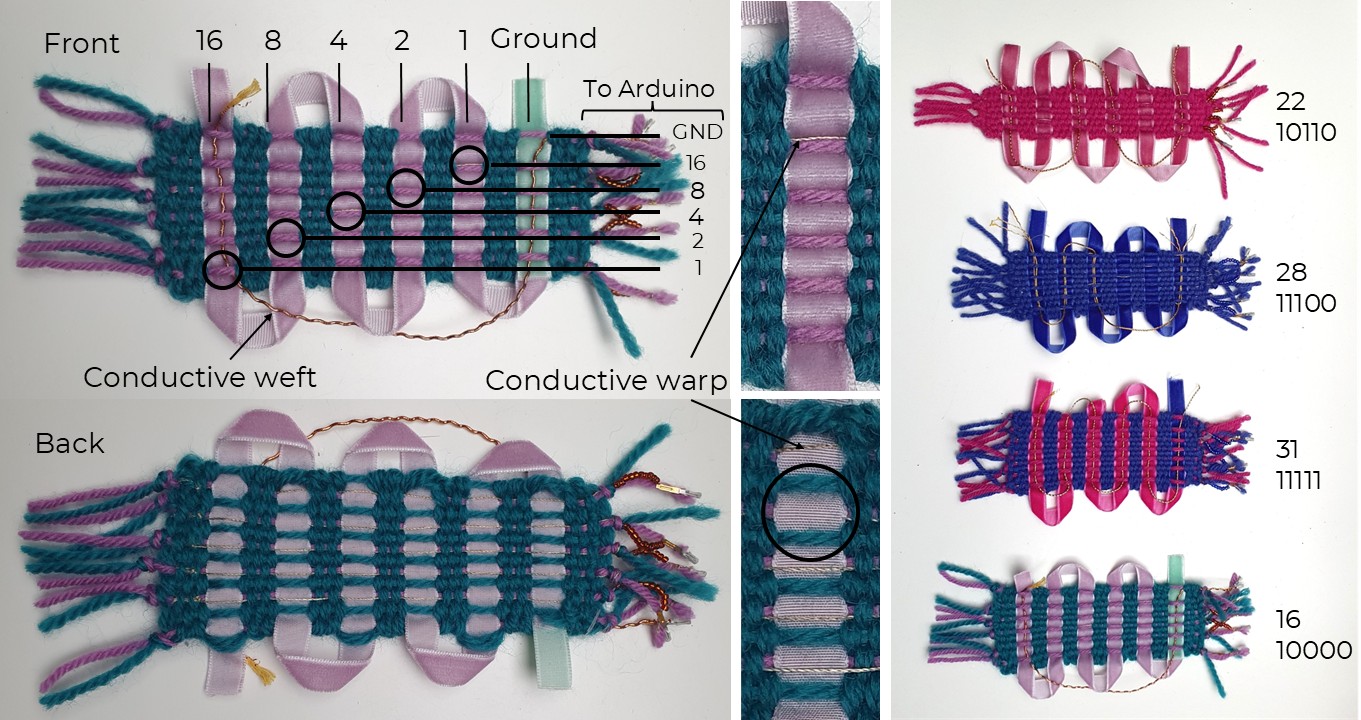
To create an interactive demonstrator, an LED passementerie weaving was created by using a strip of flexible addressable LEDs as decorative warp. 5 LEDs represented the 5 digits of the binary number, lighting up blue for 1, and purple for 0. All samples worked, a seen in Figure 6, but would need further work to make them robust enough for repeated handling.
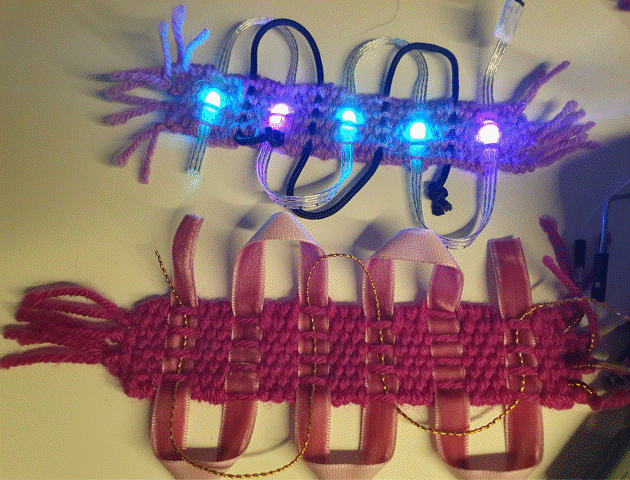
Although the focus of this project was on binary number visualisation, there are many other possibilities for combining e-textiles and passementerie. An additional demonstrator was made to illlustrate this: a passementerie touch sensor controls the brightness of an illuminated LED weaving. Here, Adafruit ‘nOOds’ are used as the decorative weft in the LED weaving. These are narrow flexible LED strips encased in a flexible coating, normally used to create Edison-style LED bulbs. The touch sensor weaving has a conductive gold yarn used as a decorative weft, used in combination with an Arduino Uno to act as a capacitive sensor. This is a simple example and is not really an example of an algorithmic pattern, but could be expanded to create more complex circuits. For example, tapping the sensor in a defined pattern, and then flashing the LEDs in that same pattern, could be used to encode Morse code in passementerie.
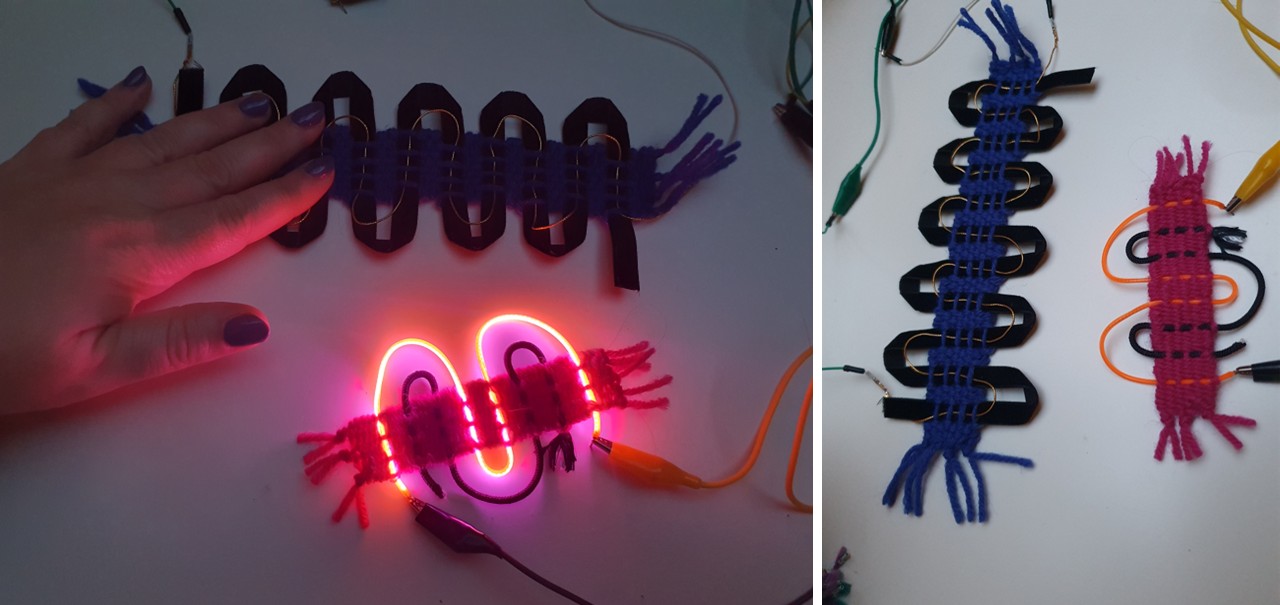
Figure 7: A capacitive touch sensor passementerie sample controlling the lighting of an LED passementerie sample with an Adafruit ‘nOOd’ flexible LED strip as decorative weft.
This project investigated the use of patterns in passementerie to represent binary numbers, and demonstrated this using e-textiles. But this has only scratched the surface of the potential for algorithmic patterns and interactivity in passementerie. I aim to continue working on the p5.js animation of passmenenterie to build an interactive design tool, but would be interested to see what could also be done with live coding and passementerie, what weaving practitioners with more in-depth knowledge of the craft could produce, or the application of generative algorithms to produce novel passementerie designs. It would also be possible to use passementerie design as a form of steganography, where the patterns represent hidden messages, or to construct passementerie logic gates as a form of textie computing. Future work could also incorporate e-textile passementerie into upholstery or clothing. As passementerie has traditionally been a luxury craft, which only the rich could access, I like the idea of using creative technology to make it accessible to more people, building on the efforts of passementerie practitioners to share their knowledge and keep the craft alive.
Thanks to Elizabeth Ashdown for sharing her knowledge on how to make passementerie, without which this project would not have happened. This work was written by a human (i.e. the author), but the AI tool Microsoft Copilot assisted by converting code I originally wrote in Processing into p5.js (mostly successfully, but with a few errors that had to be corrected). It also helped format the citations correctly, which were also double checked because it didn’t get all of them right.
Arduino code used to make both interactive demonstrators can be found here.
Heritage Crafts. “Passementerie.” Heritage Crafts. Accessed June 8, 2025. https://www.heritagecrafts.org.uk/craft/passementerie/↩︎
Elizabeth Ashdown, Passementerie: Handcrafting Contemporary Trimmings, Fringes, Tassels, and More (Atglen, PA: Schiffer Craft, 2024).↩︎
Jessica Light, Passementerie: Woven and Non-Woven Techniques for Making Trims and Tassels (Ramsbury, UK: The Crowood Press Ltd, 2025).↩︎
Anna Crutchley, Decorative Tassels and How to Make Them: The Complete Practical Guide to Passementerie, with Techniques and Projects (London: Aquamarine, 2012).↩︎
Lee Jones and Sara Nabil, “Goldwork Embroidery: Interviews with Practitioners on Working with Metal Threads and Opportunities for E-textile Hybrid Crafts,” - Proceedings of Creativity and Cognition (C&C ’22), June 20–23, 2022, Venice, Italy, ACM, accessed June 8, 2025,https://doi.org/10.1145/3527927.3532809.↩︎
Lee Jones et al., “Interactive Bobbin Lace: Metal Thread History, Interviews with Lacemakers, and Material Explorations with E-textiles,” Proceedings of the Nineteenth International Conference on Tangible, Embedded, and Embodied Interaction (TEI ’25), March 4–7, 2025, Bordeaux/Talence, France, ACM, accessed June 8, 2025, https://doi.org/10.1145/3689050.3704957.↩︎
Ebru Kurbak, ed., Stitching Worlds: Exploring Textiles and Electronics (Berlin: Revolver Publishing, 2018).↩︎
Katherine Townsend, Sarah Kettley, and Sarah Walker, “The Electric Corset and Other Future Histories,” in Crafting Anatomies: Archives, Dialogues, Fabrications, ed. Katherine Townsend, Rhian Solomon, and Amanda Briggs-Goode (London: Bloomsbury, 2022), 89–110.↩︎
Laura Devendorf et al., “AdaCAD: Parametric Design as a New Form of Notation for Complex Weaving,” Proceedings of the 2023 CHI Conference on Human Factors in Computing Systems (CHI ’23), April 2023, Hamburg, Germany, ACM, accessed June 8, 2025, https://doi.org/10.1145/3544548.3581571.↩︎
Alex McLean, Algorithmic Pattern, accessed June 8, 2025, https://algorithmicpattern.org.↩︎
Sean Cotterill and Toni Buckby, “Sampler/Sampler—Investigating Blackwork Embroidery through Live Coding Performance,” Proceedings of the International Conference on Live Coding (ICLC ’17), 2017, accessed June 8, 2025↩︎